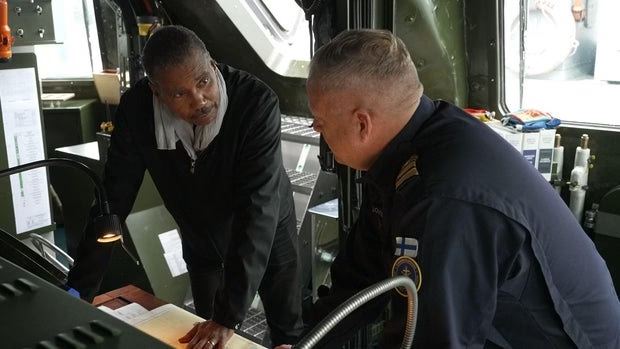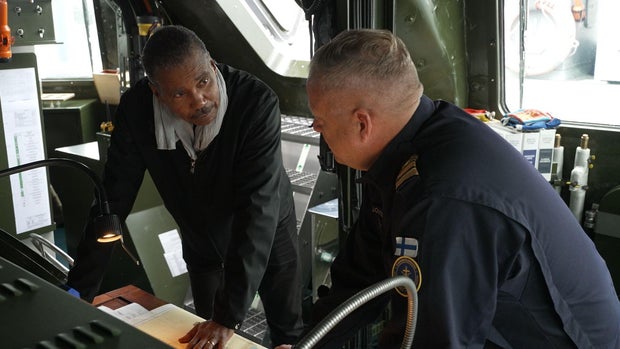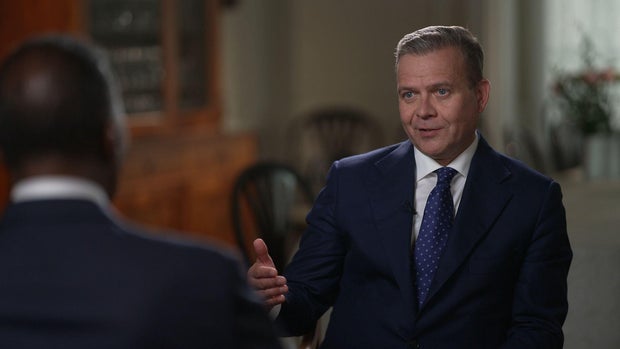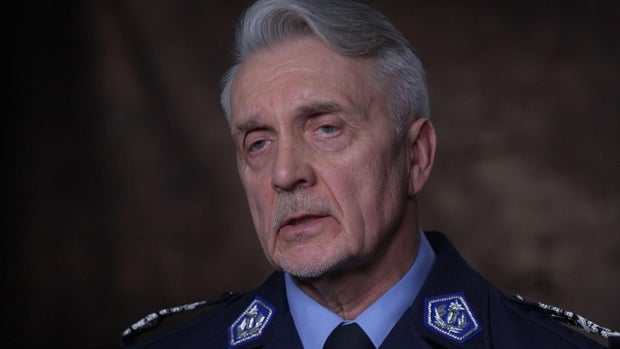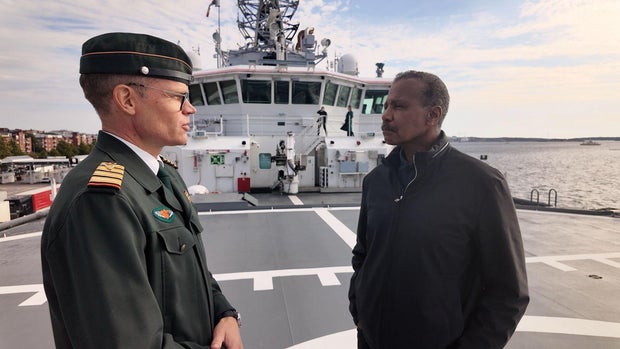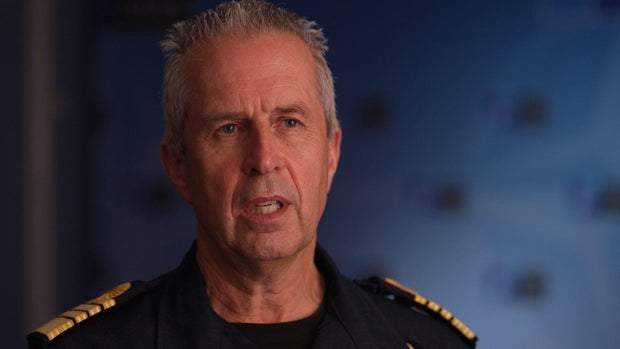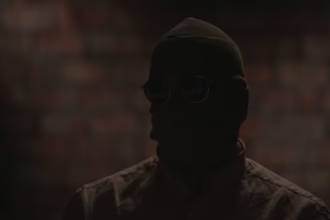As tensions rise between Europe and Russia, Russian aircraft have pierced NATO airspace in Poland, Romania and Estonia in recent weeks. And in the Baltic Sea, another incident has raised the stakes even higher. A tanker named the Eagle S was tracked dragging its anchor across the seafloor – leaving severed cables in its wake.
Undersea cables carry the lifeblood of modern existence: electricity, gas, digital communications, global banking, the internet itself. Without the cables, all that would grind to a halt. In the past two years, at least 11 cables have been cut in the Baltic, primarily in the waters off Finland, which shares an 832-mile border with Russia.
Who’s behind the rash of breaks is a mystery, but this much is known: before Russia’s war with Ukraine, these types of incidents were extremely rare.
We cut across the Baltic Sea in this small Navy dinghy looking for clues to a nautical whodunnit. We headed for the 170-foot Finnish minesweeper, Vahterppaa. This massive ship, towering above us, is a crucial part of Finland’s maritime defenses, guarding these waters between Russia to the east and Estonia to the south.
Bill Whitaker: Everything is quite close here. You’ve got Estonia. You’ve got this– you’ve got Russia.
Commander Toni Joutsia: Yes.
Bill Whitaker: You’ve got Finland, Sweden, all come together right in this area.
60 Minutes
Chief of Staff of the Finnish Navy, Toni Joutsia, told us the ship uses remote vehicles to monitor undersea cables in the Gulf of Finland – a narrow, shallow stretch of the Baltic, crowded with thousands of vessels, many of them carrying Russian oil and gas to India and China through Finnish waters day and night.
Commander Toni Joutsia: We know what is happening in the Gulf of Finland at all times.
Bill Whitaker: That’s a lot to keep an eye on.
Commander Toni Joutsia: That’s true. For example, Russian– 40%, approximately, of their commercial traffic goes through the Baltic Sea.
Bill Whitaker: And a lot of that is the– oil transport?
Commander Toni Joutsia: Yes, definitely.
It was one of those ships, the Eagle S, loaded with Russian gas, headed to Egypt, that triggered a nationwide alarm in Finland on Christmas Day 2024.
Prime Minister Petteri Orpo: I remember it very clearly, because I was here in my residence with my family, with my old father, spending Christmas Day.
Prime Minister Petteri Orpo got an urgent call from Finland’s Border Guard that shattered the holiday calm.
Prime Minister Petteri Orpo: I was told that we have problem with electricity cable between Finland and Estonia.
60 Minutes
A critical undersea electric cable, Estlink-2, had been severely damaged 50 miles off the Finnish coast. Because there had been five other recent, suspicious cable and gas line breaks, the Border Guard told the prime minister it suspected this one was deliberately severed by a ship.
Bill Whitaker: What did they say?
Prime Minister Petteri Orpo: They told me there is suspected ship named Eagle S in area. And they are on their way to the place. And they are ready to react.
With the Eagle S near Finnish territorial waters, Prime Minister Orpo authorized the extraordinary step of moving to intercept the tanker.
Prime Minister Petteri Orpo: I made a phone call to the chief of the Border Guard. And I said to him, “you can trust that you have my and my government’s full support. Use all the tools you have.”
Finland called all hands-on-deck. As the Coast Guard vessel Turva sped toward the Eagle S, police and Finland’s National Bureau of Investigation monitored from shore.
Jari Liukku: We had the possibility to intervene and apprehend and secure the evidence.
Helsinki Police Chief Jari Liukku, says the Coast Guard radioed the Eagle S asking if its anchors were up and secure. The reply was, “Yes, sir, our anchors are secured.” But three hours later, at 6 p.m., as the Turva closed in, the crew could see that was not true. The anchor chain was hanging in the water.
Jari Liukku: We had a strong reason to believe that it was an intentional activity from their side.
Liukku was informed that a total of five crucial undersea cables along the route of the Eagle S had been broken that day, and the ship was still on the move.
Jari Liukku: Of course there was a risk that the criminal activity may continue, unless the authorities intervened.
60 Minutes
Just after midnight, as the ship entered Finnish waters, Finland dispatched an armed team of special forces to the Eagle S by helicopter. They dropped onto the vessel in the dark and seized control from about two dozen crewmen from the countries of Georgia and India.
Jari Liukku: The police, and the Border Guard, and the Defense Force were actually taking over the bridge.
Bill Whitaker: Is that unusual?
Jari Liukku: Well, it was first time when, after the Second World War when Finnish troops boarded a boat.
Bill Whitaker: The first time since the Second World War–
Jari Liukku: Yeah, that’s right. Because we had to do something in that case.
Risto Lohi: There was imminent threat that other critical infrastructure between Finland/Estonia would be damaged.
Risto Lohi, overseeing the Eagle S case for Finland’s National Bureau of Investigation, told us the next cables in the Eagle S’ path could have strained Estonia’s electricity and gas supply.
Risto Lohi: So there was also a necessity to intervene.
This is underwater video of the crime scene. Finnish investigators determined the Eagle S had raked its anchor across the sea bottom for more than six hours. When the ship was ordered to haul it up, the anchor was so battered it snapped off the chain.
Risto Lohi: We found the anchor. And the drag mark on the seabed started from the first damaged cable, and the drag mark was continuous until the location when the vessel was stopped.
Police handed their evidence to Finnish prosecutors, who charged the captain and the Eagle S’ two senior officers with aggravated criminal mischief, and interference with communications. They pleaded not guilty. The damaged cables cost $70 million to repair. The case is still underway. In court, the captain claimed the anchor had been dragged by accident.
Bill Whitaker: How far did they drag this anchor?
Commander Mikko Simola: Approximately 100 kilometers all together.
That’s 66 miles before the Coast Guard cutter Curva confronted and ultimately stopped the Eagle S. Commander Mikko Simola told us the tankers’ behavior raised serious alarm.
Bill Whitaker: There are failsafe measures on the anchor to keep it from dropping accidentally, are there not?
Commander Mikko Simola: Certainly there are safety mechanisms.
60 Minutes
Bill Whitaker: They’re like, three different safety mechanisms —
Commander Mikko Simola: Yeah, yeah. Different safety mechanisms.
Bill Whitaker: The captain of the ship says that he didn’t know that the anchor had been lowered and dragged for 66 miles. Is that believable?
Commander Mikko Simola: It’s hard to believe, being a Coast Guard officer, certainly. A captain of the vessel must always know whether the anchor is hoisted or in the sea. So interesting comment. This is what I could say.
Bill Whitaker: An interesting comment.
Commander Mikko Simola: Yeah, certainly.
More suspicious? The ownership of the 20-year-old Eagle S. A seven-month investigation by 60 Minutes found its owners hidden behind layers of shell companies. Public records list the primary owner as a woman from Azerbaijan, with an office in Dubai. The ship is managed by a company in India and leased to a major Russian oil company. That oil company has financed a fleet of hard-to-trace tankers to move Russian oil, evading Western sanctions.
Prime Minister Petteri Orpo: This is phenomenon we called Russian shadow fleet.
Bill Whitaker: Shadow fleet?
Prime Minister Petteri Orpo: Shadow fleet. It is pumping money to Putin’s war machine.
Bill Whitaker: He’s still making–
Prime Minister Petteri Orpo: Yes, it is–
Bill Whitaker: — profit off of Russian oil.
Prime Minister Petteri Orpo: Yes.
Bill Whitaker: Even though the sanctions are in place.
Prime Minister Petteri Orpo: Yes.
Prime Minister Orpo told us the shadow fleet’s constant presence in the Baltic Sea is raising the temperature with Russia – barely 200 miles across the water.
Bill Whitaker: Do you consider Russia a threat?
Prime Minister Petteri Orpo: Of course, Russia is threat. We can see what they have done against Ukraine. And also, in Finland we have seen many hybrid attacks.
Bill Whitaker: What do you mean by hybrid attacks?
Prime Minister Petteri Orpo: We have seen these incidents in, by Baltic Sea. We have seen sabotage in Europe. So we are not in the war, but we are under attack.
Bill Whitaker: You’re not in war.
Prime Minister Petteri Orpo: No, we are not in war.
Bill Whitaker: But you’re under attack.
Prime Minister Petteri Orpo: Because we are the target.
Beyond recent Russian aircraft incursions into NATO airspace, EU officials have connected Russia to numerous attacks in Europe: firebombings, assaults on rail and arms depots, explosive packages, and now the mystery of the Eagle S.
Bill Whitaker: This breaking of the undersea cables, this was not happening before the outbreak of war between Russia and Ukraine?
Prime Minister Petteri Orpo: No. We didn’t have any this kind of incidents before Russian aggression against Ukraine. But after that, we have had many.
Bill Whitaker: So I have to ask what seems to be the obvious question. Is this Russia?
Prime Minister Petteri Orpo: I can only say that was clear connection between Russian shadow fleet and these incidents. It’s clear.
Bill Whitaker: Does it feel as though Russia is probing and prodding to find soft spots in not just Finland’s defenses but NATO’s?
Prime Minister Petteri Orpo: This is their way to try to harm us, make us afraid.
Prime Minister Orpo says the Eagle S was a test of Finland’s resolve.
Prime Minister Petteri Orpo: We sent a clear signal to the shadow fleet and maybe to the actors behind, that we have our limits.
Finland joined NATO in 2023. The alliance recently launched operation Baltic Sentry, deploying ships and planes to monitor the shadow fleet and safeguard critical seabed infrastructure. British Admiral Keith Blount, NATO’s deputy supreme allied commander, told us the Eagle S incident was a provocation that demanded a response.
60 Minutes
Admiral Keith Blount: We launched a response to try and deter, prevent, similar incidents happening again in the Baltic. So it was kind of a triggering event for us. And of course we haven’t seen another incident since we established Baltic Sentry.
Bill Whitaker: What is the message that Baltic Sentry is sending?
Admiral Keith Blount: We’re not gonna be pushed around, interfered with. We’re not gonna be subject to illegal behaviors that either threaten the rule of law, or worse, threaten the safety and security of our people.
Because of its connection to the shadow fleet, the Eagle S was sanctioned by the EU, England and Canada, restricting its access to ports.
Bill Whitaker: On the face of it, the incident seems to be a small thing, but when I see your reaction, when I see NATO’s reaction, that Eagle S incident has turned out to be quite a big deal.
Prime Minister Petteri Orpo: Yes, it was a big deal. We have to react. And it was first time we react. We show that we are ready to defend our critical infrastructure, our property. And that’s why it was turning point.
Bill Whitaker: We have a saying in the United States, “Enough is enough.”
Prime Minister Petteri Orpo: Yes. Enough is enough.
Produced by Oriana Zill de Granados. Field producer, Sabina Castelfranco. Associate producer, Emily Gordon. Broadcast associate, Mariah Johnson. Edited by Mike Levine.


